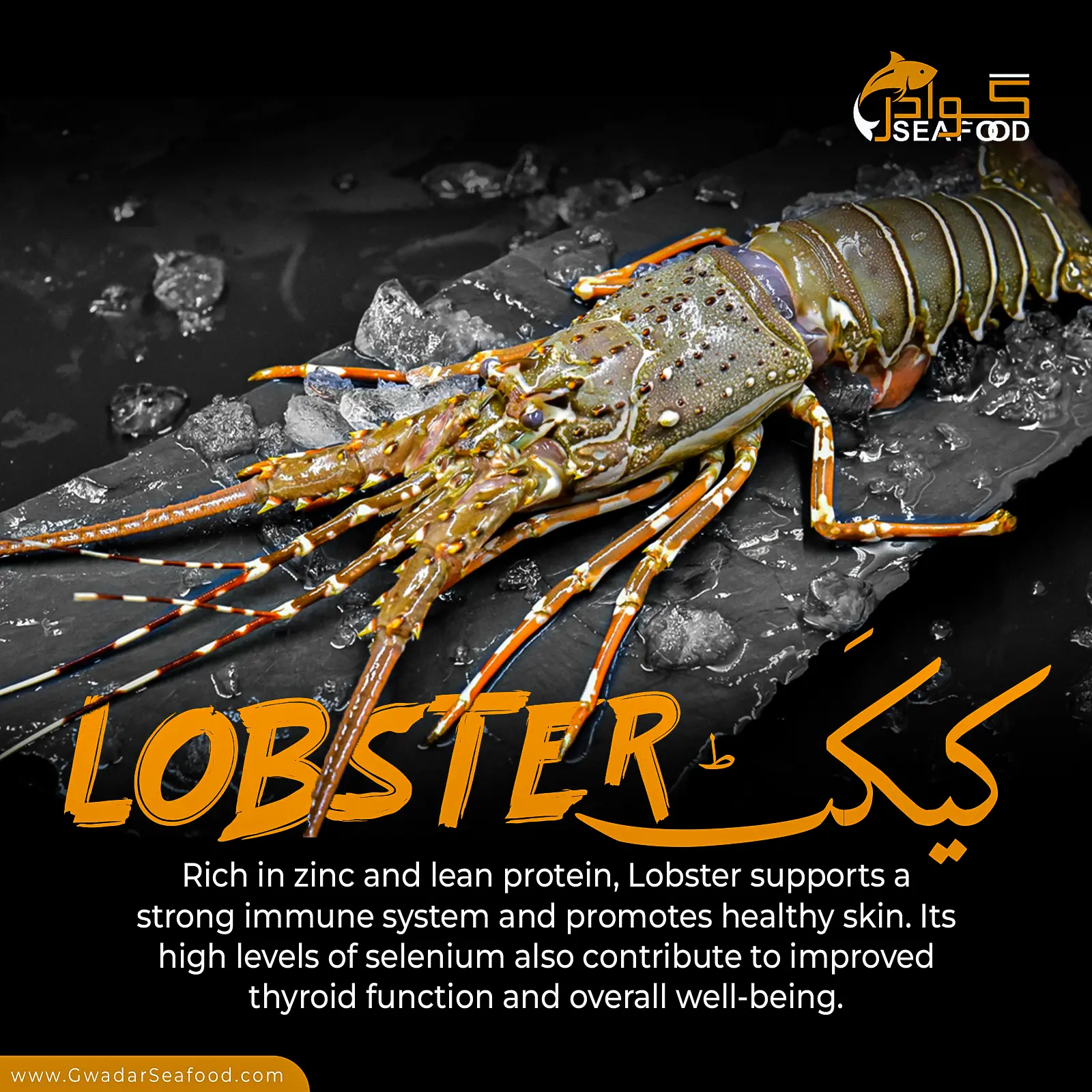Introduction
The Spiny Lobster, locally known as Kikat (کیکٹ) in Pakistan, is a type of lobster recognized for its lack of large claws, which distinguishes it from the true lobster species. Instead of claws, Spiny Lobsters possess long, spiny antennae and hard exoskeletons, making them unique among crustaceans. They are highly prized for their succulent, sweet meat and delicate texture, making them a luxury ingredient in fine dining.
Found primarily in the Arabian Sea, the Spiny Lobster is particularly abundant along the coasts of Karachi and Balochistan, where it inhabits rocky reefs and sandy substrates. This lobster species is known for its vibrant shell, which can range from yellowish-brown to dark blue, and its distinct spines along its back. The Kikat Lobster is highly sought after for its flavorful and sweet meat, which is prized in various gourmet recipes across the world.
Habitat
Spiny Lobsters are typically found in shallow, rocky coastal waters and reefs, where they can take shelter in crevices and holes during the day. These crabs are typically bottom dwellers, using their natural spines for defense against predators. They are most commonly found in depths of 5–60 meters, with an emphasis on environments such as coral reefs, mangrove forests, and sandbars. In Pakistan, they are abundant in the coastal regions of Karachi, Balochistan, and Gwadar, where the rocky and sandy habitats provide perfect hiding places for these lobsters.
These lobsters prefer environments with clean, unpolluted waters, which allow them to maintain healthy growth and development. The Arabian Sea provides ideal conditions for their survival, offering abundant food sources and protection from strong predators.
Diet
Spiny Lobsters are omnivorous and exhibit opportunistic feeding behaviors. They consume a wide variety of marine organisms, including small fish, mollusks, crustaceans, and detritus. Their long, spiny antennae help them detect and locate prey, while their robust body structure allows them to crush and break open their food.
Their diet contributes to their sweet, succulent meat, with a subtle flavor profile that complements various cooking styles. Lobsters feed during the night, typically foraging on the sea floor, using their antennae to detect vibrations and locate food. This makes them efficient scavengers, capable of adapting to changing food availability in their environment.
Growth
Spiny Lobsters have a slow growth rate, taking 5 to 7 years to reach maturity in optimal conditions. Growth is a gradual process that occurs through periodic molting, during which the lobster sheds its old exoskeleton and grows a new, larger one. Spiny Lobsters grow by 5–10 cm per year, depending on the availability of food and environmental conditions.
Due to their slow growth rate and long maturation period, Spiny Lobsters are particularly vulnerable to overfishing. This makes it crucial to implement sustainable harvesting practices, such as catch limits and size restrictions, to preserve the population. They typically breed once they reach sexual maturity, with females releasing hundreds of thousands of eggs that hatch into larvae and drift in the water column until they settle on the seafloor.
Concise Addition: Spawning & Conservation
Spiny Lobsters spawn in warmer months, releasing eggs that hatch into larvae, which then drift in the water column for several months before reaching the seafloor. The larvae undergo a series of developmental stages before settling on the bottom to mature into juvenile lobsters.
Conservation of Spiny Lobsters is a pressing concern due to their slow growth and low reproductive rates. Overfishing and habitat destruction pose serious threats to their populations, and efforts are being made globally to enforce sustainable harvesting methods. Measures like size limits, catch quotas, and no-catch zones are being implemented to ensure the continued health of Spiny Lobster populations. Preserving their natural habitats, such as mangroves and coral reefs, is also essential for their survival.
Names & Taxonomy
-
Common Name: Spiny Lobster
-
Local Name in Pakistan: Kikat (کیکٹ)
-
Scientific Name: Panulirus polyphagus
-
Family: Palinuridae
-
Order: Decapoda
-
Class: Malacostraca
The Spiny Lobster belongs to the Palinuridae family, which is characterized by long antennae and spiny exoskeletons. Unlike true lobsters, Spiny Lobsters do not have large claws, but instead have long, sharp spines covering their bodies, giving them a distinct appearance and offering protection against predators. Their smooth bodies and robust limbs make them effective at navigating through rocky crevices and hiding from potential threats.
Sourcing & Catching Method
Spiny Lobsters are primarily wild-caught using trap fishing, gillnets, and hand-catching methods. The fishing season typically spans from late spring to early autumn, when lobsters are most abundant. In Pakistan, they are harvested mainly from the Karachi and Balochistan regions, where the rocky, shallow waters are home to these elusive creatures.
Sustainable fishing practices are essential for maintaining healthy lobster populations. These include implementing catch limits, closed fishing seasons, and size restrictions to allow the lobster population to replenish. In addition, fishermen use traditional traps and nets that minimize bycatch and reduce environmental harm, ensuring that the ecosystem remains balanced while allowing for a healthy harvest of lobsters.
Physical Traits & Texture
-
Shell Color: The Spiny Lobster typically has a yellow-brown shell with various darker markings and a smooth, spiny appearance.
-
Antennae: They are equipped with long, spiny antennae, which are used to detect prey and navigate through their environment.
-
Body Structure: The lobster’s body is long, flattened, and covered in spines, providing protection against predators.
-
Meat Texture: The meat is sweet, succulent, and firm, with a slightly buttery texture. It is often described as delicate, yet flavorful.
-
Size: Spiny Lobsters typically grow to 15–25 cm in length, but larger specimens can reach 50 cm.
Spiny Lobster meat is highly regarded for its delicate flavor and firm texture. The clawless design of the Spiny Lobster results in a higher yield of tail meat, which is considered the most desirable part of the lobster.
Cutting Options & Yields
| Option | Approx. Yield | Best For |
|---|---|---|
| Whole (uncleaned) | ~100% | Whole roasts, soups, and broths |
| Tails Only (head removed) | ~30% | Grilling, baking, and sushi |
Cooking Ideas – Versatile, Rich & Crowd-Friendly
-
Grilled Spiny Lobster: Marinate with garlic, butter, and lemon, then grill for a smoky flavor.
-
Lobster Bisque: A creamy, flavorful soup made with lobster meat, cream, and vegetables.
-
Lobster Curry: Cook with tomatoes, coconut milk, and spices for a rich, aromatic dish.
-
Lobster Salad: Lightly boil the lobster and toss with fresh greens, avocado, and a tangy vinaigrette for a refreshing meal.
-
Lobster Pasta: Incorporate lobster meat into a garlicky pasta with a creamy white wine sauce.
Tips for Selecting Fresh Lobster (Kikat)
-
Shell: Look for a hard, smooth shell without cracks or signs of damage.
-
Claws: The claws should be full, muscular, and undamaged.
-
Antennae: The antennae should be long and undamaged, indicative of a fresh lobster.
-
Smell: Fresh Spiny Lobster should have a clean, ocean-like smell, not an overpowering fishy odor.
-
Movement: When alive, the lobster should be active and responsive to touch. If the lobster is sluggish, it may be past its prime.
Tips for Storing Lobster
-
Refrigeration: Store live lobsters in the refrigerator at 0–4°C and consume within 1–2 days for the best taste.
-
Freezing: For longer storage, freeze the lobsters in airtight containers. Best consumed within 1–2 months when frozen.
-
Avoid Thawing and Refreezing: Repeated thawing and refreezing can degrade the quality of the meat and impact its texture and flavor.
Nutrition Highlights (per 100 g raw meat)
-
Calories: ~120 kcal
-
Protein: ~23 g
-
Fat: ~1.5 g
-
Carbohydrates: ~3 g
-
Sodium: ~200 mg
-
Cholesterol: ~80 mg
-
Omega-3 Fatty Acids: Present in significant amounts.
-
Iron: ~0.74 mg
-
Calcium: ~89 mg
Spiny Lobster is an excellent source of high-quality protein, low-fat content, and omega-3 fatty acids, making it a great option for a healthy, nutritious meal. It also contains iron and calcium, which support overall health.
Need Something Similar?
-
Slipper Lobster: For a firmer texture and richer flavor.
-
Mud Crab: Offers a stronger taste and is ideal for curries.

 Sea Fish
Sea Fish
Reviews
There are no reviews yet.